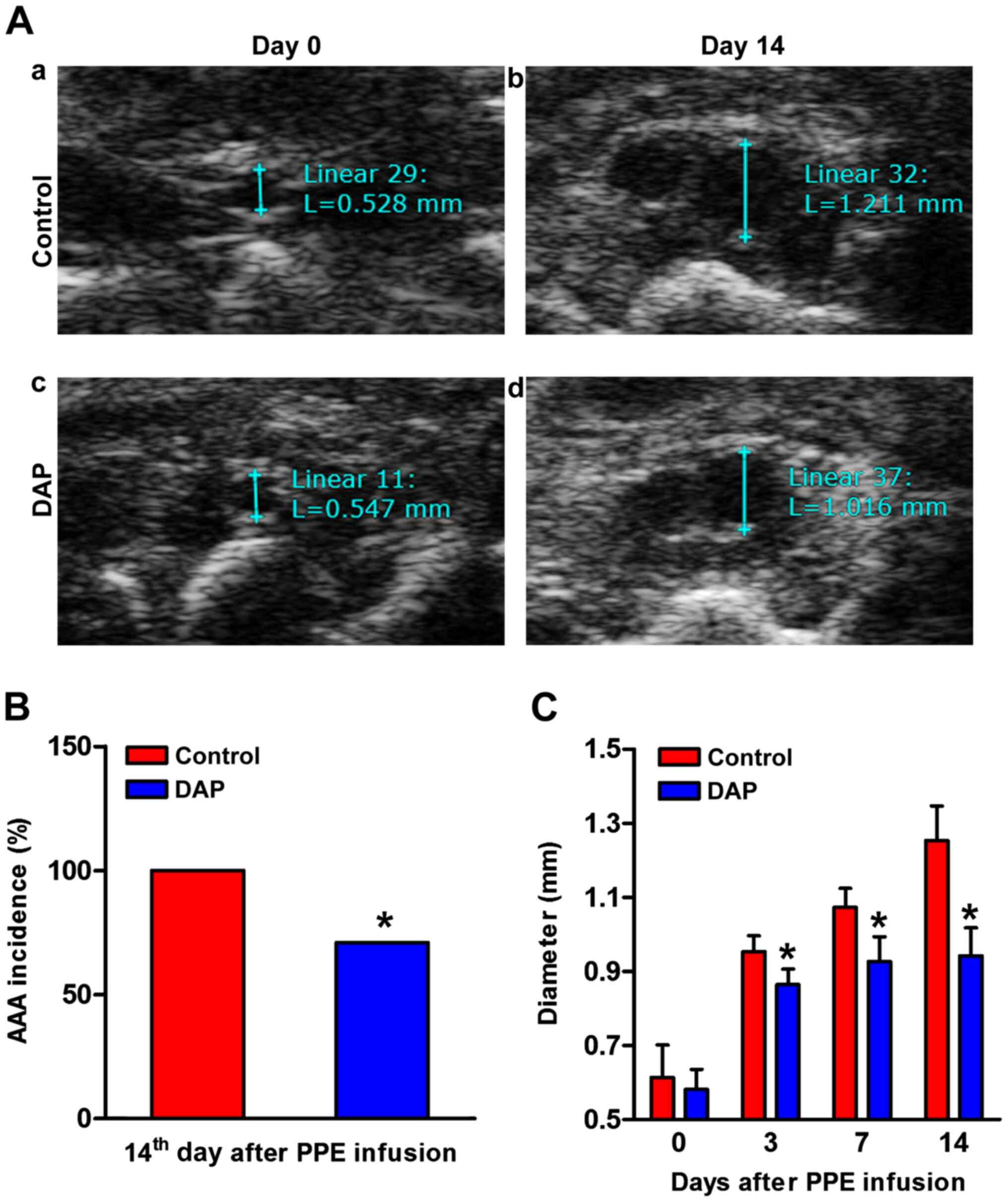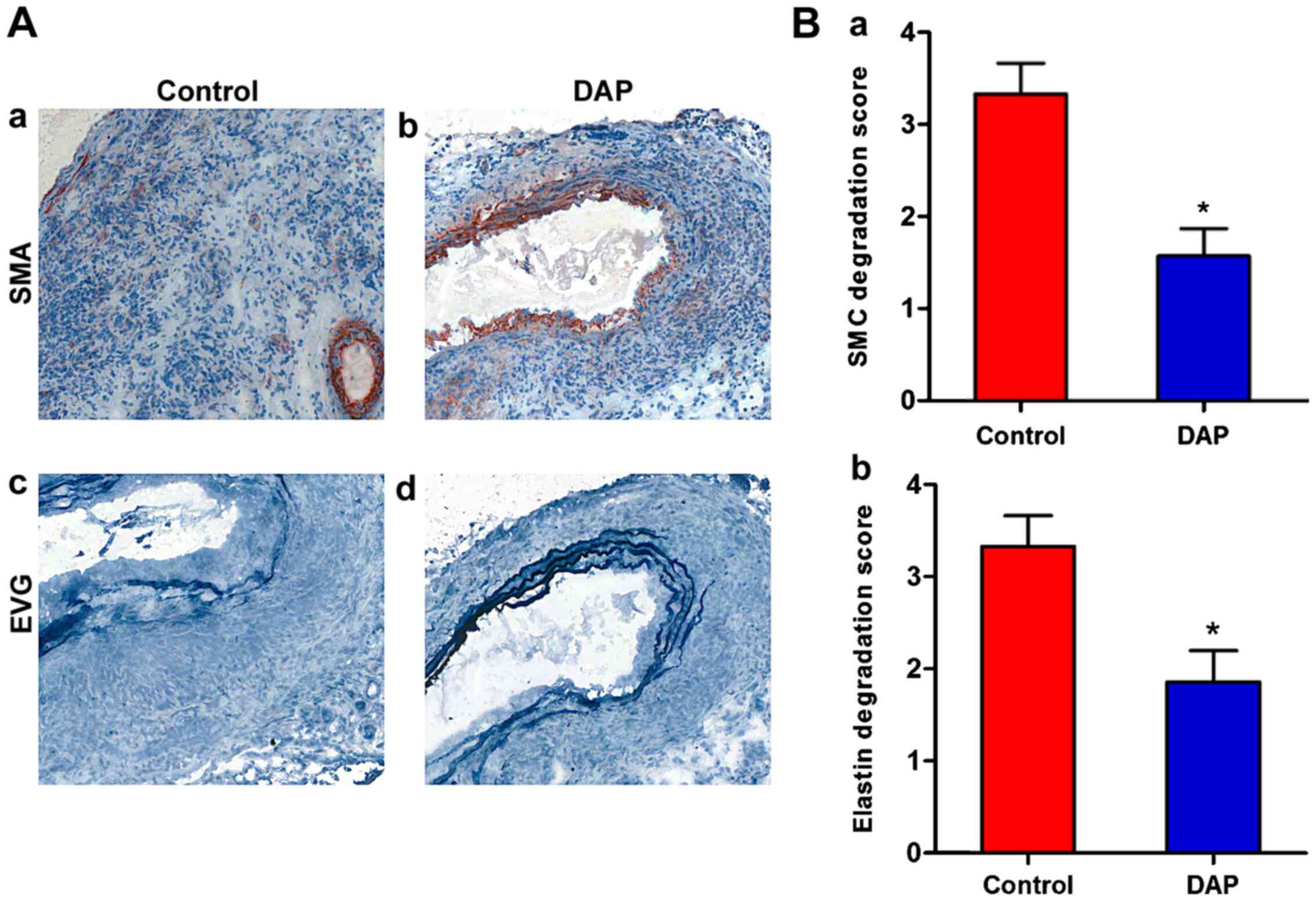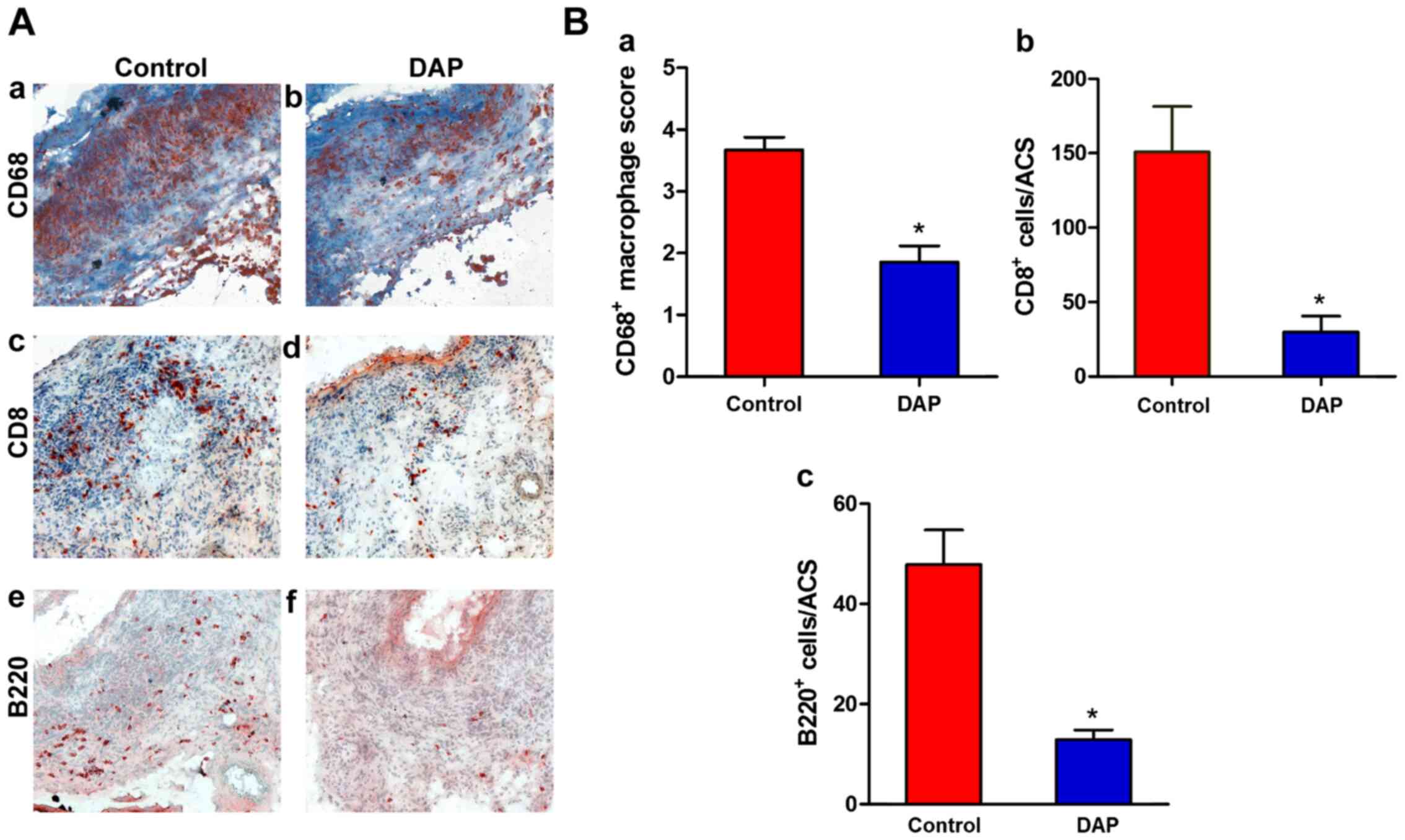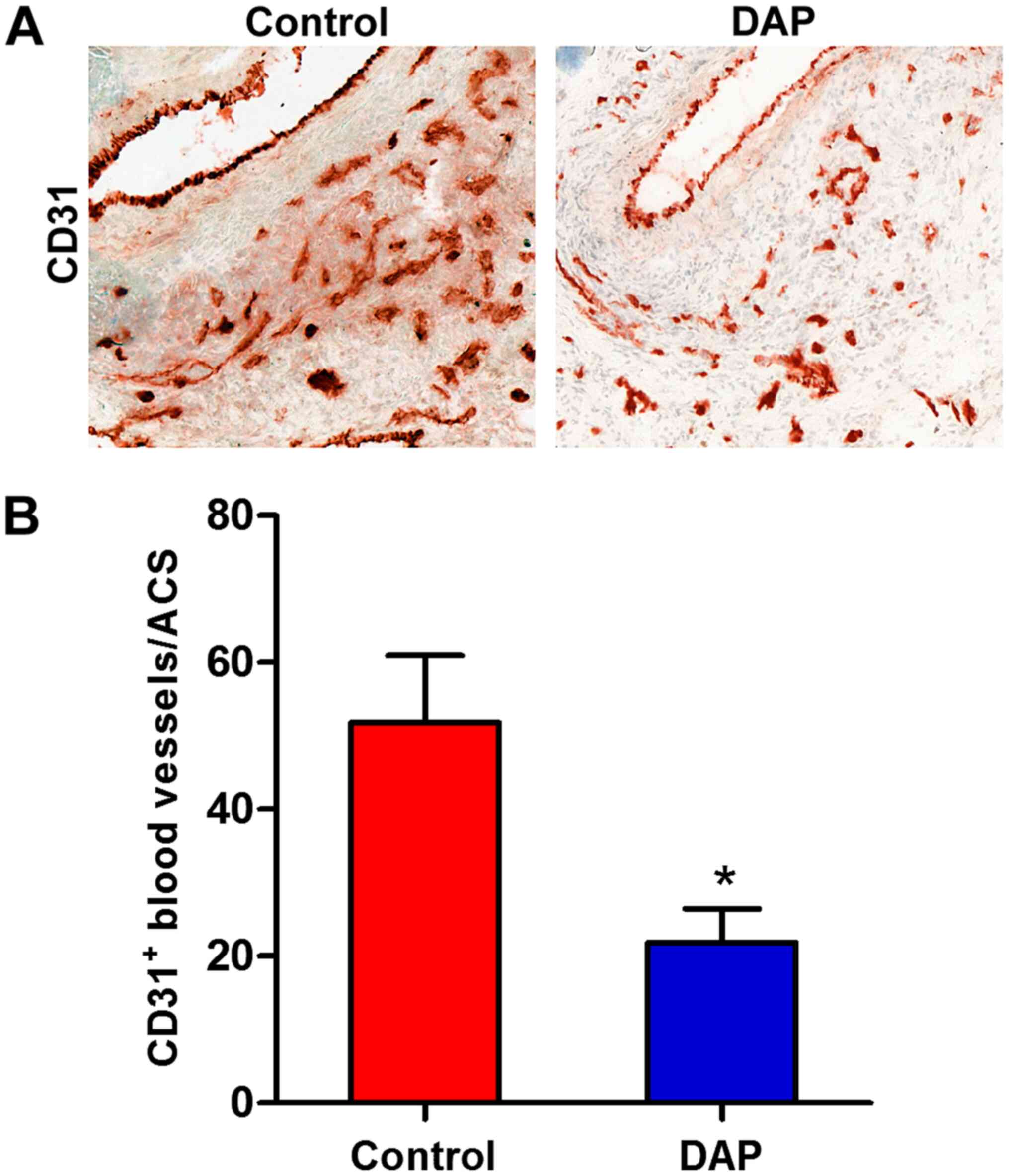|
1
|
Golledge J, Muller J, Daugherty A and
Norman P: Abdominal aortic aneurysm: Pathogenesis and implications
for management. Arterioscler Thromb Vasc Biol. 26:2605–2613.
2006.PubMed/NCBI View Article : Google Scholar
|
|
2
|
Miyake T and Morishita R: Pharmacological
treatment of abdominal aortic aneurysm. Cardiovasc Res. 83:436–443.
2009.PubMed/NCBI View Article : Google Scholar
|
|
3
|
Rouer M, Xu BH, Xuan HJ, Tanaka H,
Fujimura N, Glover KJ, Furusho Y, Gerritsen M and Dalman RL:
Rapamycin limits the growth of established experimental abdominal
aortic aneurysms. Eur J Vasc Endovasc Surg. 47:493–500.
2014.PubMed/NCBI View Article : Google Scholar
|
|
4
|
Greenhalgh RM, Brown LC, Kwong GP, Powell
JT and Thompson SG: EVAR trial participants: Comparison of
endovascular aneurysm repair with open repair in patients with
abdominal aortic aneurysm (EVAR trial 1), 30-day operative
mortality results: Randomised controlled trial. Lancet.
364:843–848. 2004.PubMed/NCBI View Article : Google Scholar
|
|
5
|
Badger S, Forster R, Blair PH, Ellis P,
Kee F and Harkin DW: Endovascular treatment for ruptured abdominal
aortic aneurysm. Cochrane Database Syst Rev.
5(CD005261)2017.PubMed/NCBI View Article : Google Scholar
|
|
6
|
Anderson RN: Deaths: Leading causes for
2000. Natl Vital Stat Rep. 50:1–85. 2002.PubMed/NCBI
|
|
7
|
Xuan H, Xu B, Wang W, Tanaka H, Fujimura
N, Miyata M, Michie SA and Dalman RL: Inhibition or deletion of
angiotensin II type 1 receptor suppresses elastase-induced
experimental abdominal aortic aneurysms. J Vasc Surg.
67:573–584.e2. 2018.PubMed/NCBI View Article : Google Scholar
|
|
8
|
Lederle FA, Wilson SE, Johnson GR, Reinke
DB, Littooy FN, Acher CW, Ballard DJ, Messina LM, Gordon IL, Chute
EP, et al: Immediate repair compared with surveillance of small
abdominal aortic aneurysms. N Engl J Med. 346:1437–1444.
2002.PubMed/NCBI View Article : Google Scholar
|
|
9
|
Rehm JP, Grange JJ and Baxter BT: The
formation of aneurysms. Semin Vasc Surg. 11:193–202.
1998.PubMed/NCBI
|
|
10
|
Michel JB, Martin-Ventura JL, Egido J,
Sakalihasan N, Treska V, Lindholt J, Allaire E, Thorsteinsdottir U,
Cockerill G and Swedenborg J: FAD EU consortium: Novel aspects of
the pathogenesis of aneurysms of the abdominal aorta in humans.
Cardiovasc Res. 90:18–27. 2011.PubMed/NCBI View Article : Google Scholar
|
|
11
|
Li G, Yang L, Yuan H, Liu Y, He Y, Wu X
and Jin X: Cold-inducible RNA-binding protein plays a central role
in the pathogenesis of abdominal aortic aneurysm in a murine
experimental model. Surgery. 159:1654–1667. 2016.PubMed/NCBI View Article : Google Scholar
|
|
12
|
Lindberg S, Zarrouk M, Holst J and
Gottsater A: Inflammatory markers associated with abdominal aortic
aneurysm. Eur Cytokine Netw. 27:75–80. 2016.PubMed/NCBI View Article : Google Scholar
|
|
13
|
Xiong W, MacTaggart J, Knispel R, Worth J,
Persidsky Y and Baxter BT: Blocking TNF-alpha attenuates aneurysm
formation in a murine model. J Immunol. 183:2741–2746.
2009.PubMed/NCBI View Article : Google Scholar
|
|
14
|
de Waard V, Bot I, de Jager SC, Talib S,
Egashira K, de Vries MR, Quax PH, Biessen EA and van Berkel TJ:
Systemic MCP1/CCR2 blockade and leukocyte specific MCP1/CCR2
inhibition affect aortic aneurysm formation differently.
Atherosclerosis. 211:84–89. 2010.PubMed/NCBI View Article : Google Scholar
|
|
15
|
Zhu H, Qu X, Zhang C and Yu Y:
Interleukin-10 promotes proliferation of vascular smooth muscle
cells by inhibiting inflammation in rabbit abdominal aortic
aneurysm. Int J Clin Exp Pathol. 12:1260–1271. 2019.PubMed/NCBI
|
|
16
|
Hao Q, Chen X, Wang X, Dong B and Yang C:
Curcumin attenuates angiotensin ii-induced abdominal aortic
aneurysm by inhibition of inflammatory response and ERK signaling
pathways. Evid Based Complement Alternat Med.
2014(270930)2014.PubMed/NCBI View Article : Google Scholar
|
|
17
|
Sikora E, Scapagnini G and Barbagallo M:
Curcumin, inflammation, ageing and age-related diseases. Immun
Ageing. 7(1)2010.PubMed/NCBI View Article : Google Scholar
|
|
18
|
Sunagawa Y, Wada H, Suzuki H, Sasaki H,
Imaizumi A, Fukuda H, Hashimoto T, Katanasaka Y, Shimatsu A, Kimura
T, et al: A novel drug delivery system of oral curcumin markedly
improves efficacy of treatment for heart failure after myocardial
infarction in rats. Biol Pharm Bull. 35:139–144. 2012.PubMed/NCBI View Article : Google Scholar
|
|
19
|
Fan J, Li X, Yan YW, Tian XH, Hou WJ, Tong
H and Bai SL: Curcumin attenuates rat thoracic aortic aneurysm
formation by inhibition of the c-Jun N-terminal kinase pathway and
apoptosis. Nutrition. 28:1068–1074. 2012.PubMed/NCBI View Article : Google Scholar
|
|
20
|
Kaluza J, Stackelberg O, Harris HR, Bjorck
M and Wolk A: Anti-inflammatory diet and risk of abdominal aortic
aneurysm in two Swedish cohorts. Heart. 105:1876–1883.
2019.PubMed/NCBI View Article : Google Scholar
|
|
21
|
Qi Z, Qi S, Gui L, Shen L and Feng Z:
Daphnetin protects oxidative stress-induced neuronal apoptosis via
regulation of MAPK signaling and HSP70 expression. Oncol Lett.
12:1959–1964. 2016.PubMed/NCBI View Article : Google Scholar
|
|
22
|
Fylaktakidou KC, Hadjipavlou-Litina DJ,
Litinas KE and Nicolaides DN: Natural and synthetic coumarin
derivatives with anti-inflammatory/antioxidant activities. Curr
Pharm Des. 10:3813–3833. 2004.PubMed/NCBI View Article : Google Scholar
|
|
23
|
Venugopala KN, Rashmi V and Odhav B:
Review on natural coumarin lead compounds for their pharmacological
activity. Biomed Res Int. 2013(963248)2013.PubMed/NCBI View Article : Google Scholar
|
|
24
|
Liu J, Chen Q, Jian Z, Xiong X, Shao L,
Jin T, Zhu X and Wang L: Daphnetin protects against cerebral
ischemia/reperfusion injury in mice via inhibition of TLR4/NF-κB
signaling pathway. Biomed Res Int. 2016(2816056)2016.PubMed/NCBI View Article : Google Scholar
|
|
25
|
Tu L, Li S, Fu Y, Yao R, Zhang Z, Yang S,
Zeng X and Kuang N: The therapeutic effects of daphnetin in
collagen-induced arthritis involve its regulation of Th17 cells.
Int Immunopharmacol. 13:417–423. 2012.PubMed/NCBI View Article : Google Scholar
|
|
26
|
Liu ZY, Liu J, Zhao KL, Wang LK, Shi Q,
Zuo T, Liu TY, Zhao L and Wang WX: Protective effects of daphnetin
on sodium taurocholateinduced severe acute pancreatitis in rats.
Mol Med Rep. 9:1709–1714. 2014.PubMed/NCBI View Article : Google Scholar
|
|
27
|
Du G, Tu H, Li X, Pei A, Chen J, Miao Z,
Li J, Wang C, Xie H, Xu X and Zhao H: Daphnetin, a natural coumarin
derivative, provides the neuroprotection against glutamate-induced
toxicity in HT22 cells and ischemic brain injury. Neurochem Res.
39:269–275. 2014.PubMed/NCBI View Article : Google Scholar
|
|
28
|
Zhi J, Duan B, Pei J, Wu S and Wei J:
Daphnetin protects hippocampal neurons from oxygen-glucose
deprivation-induced injury. J Cell Biochem. 120:4132–4139.
2019.PubMed/NCBI View Article : Google Scholar
|
|
29
|
Chen X, Kuang N, Zeng X, Zhang Z, Li Y,
Liu W and Fu Y: Effects of daphnetin combined with Bcl2siRNA on
antiapoptotic genes in synovial fibroblasts of rats with
collageninduced arthritis. Mol Med Rep. 17:884–890. 2018.PubMed/NCBI View Article : Google Scholar
|
|
30
|
Shu K, Kuang N, Zhang Z, Hu Z, Zhang Y, Fu
Y and Min W: Therapeutic effect of daphnetin on the autoimmune
arthritis through demethylation of proapoptotic genes in synovial
cells. J Transl Med. 12(287)2014.PubMed/NCBI View Article : Google Scholar
|
|
31
|
Yu WW, Lu Z, Zhang H, Kang YH, Mao Y, Wang
HH, Ge WH and Shi LY: Anti-inflammatory and protective properties
of daphnetin in endotoxin-induced lung injury. J Agric Food Chem.
62:12315–12325. 2014.PubMed/NCBI View Article : Google Scholar
|
|
32
|
Ji J, Ge X, Chen Y, Zhu B, Wu Q, Zhang J,
Shan J, Cheng H and Shi L: Daphnetin ameliorates experimental
colitis by modulating microbiota composition and
Treg/Th17 balance. FASEB J. 33:9308–9322.
2019.PubMed/NCBI View Article : Google Scholar
|
|
33
|
Li M, Shi X, Chen F and Hao F: Daphnetin
inhibits inflammation in the NZB/W F1 systemic lupus erythematosus
murine model via inhibition of NF-κB activity. Exp Ther Med.
13:455–460. 2017.PubMed/NCBI View Article : Google Scholar
|
|
34
|
Wang D, Lu Z, Zhang H, Jin SF, Yang H, Li
YM and Shi LY: Daphnetin alleviates experimental autoimmune
encephalomyelitis via regulating dendritic cell activity. CNS
Neurosci Ther. 22:558–567. 2016.PubMed/NCBI View Article : Google Scholar
|
|
35
|
Shen L, Zhou T, Wang J, Sang X, Lan L, Luo
L and Yin Z: Daphnetin reduces endotoxin lethality in mice and
decreases LPS-induced inflammation in Raw264.7 cells via
suppressing JAK/STATs activation and ROS production. Inflamm Res.
66:579–589. 2017.PubMed/NCBI View Article : Google Scholar
|
|
36
|
Guide for the Care and Use of Laboratory
Animals. In: National Research Council of the National Academes.
8th edition. Washington, DC, 2011.
|
|
37
|
Fujimura N, Xiong J, Kettler EB, Xuan H,
Glover KJ, Mell MW, Xu B and Dalman RL: Metformin treatment status
and abdominal aortic aneurysm disease progression. J Vasc Surg.
64:46–54.e8. 2016.PubMed/NCBI View Article : Google Scholar
|
|
38
|
Iida Y, Xu B, Xuan H, Glover KJ, Tanaka H,
Hu X, Fujimura N, Wang W, Schultz JR, Turner CR and Dalman RL:
Peptide inhibitor of CXCL4-CCL5 heterodimer formation, MKEY,
inhibits experimental aortic aneurysm initiation and progression.
Arterioscler Thromb Vasc Biol. 33:718–726. 2013.PubMed/NCBI View Article : Google Scholar
|
|
39
|
Iida Y, Xu B, Schultz GM, Chow V, White
JJ, Sulaimon S, Hezi-Yamit A, Peterson SR and Dalman RL: Efficacy
and mechanism of angiotensin II receptor blocker treatment in
experimental abdominal aortic aneurysms. PLoS One.
7(e49642)2012.PubMed/NCBI View Article : Google Scholar
|
|
40
|
Halloran BG and Baxter BT: Pathogenesis of
aneurysms. Semin Vasc Surg. 8:85–92. 1995.PubMed/NCBI
|
|
41
|
Wolanska M, Bankowska-Guszczyn E,
Sobolewski K and Kowalewski R: Expression of VEGFs and its
receptors in abdominal aortic aneurysm. Int Angiol. 34:520–528.
2015.PubMed/NCBI
|
|
42
|
Trollope AF and Golledge J: Angiopoietins,
abdominal aortic aneurysm and atherosclerosis. Atherosclerosis.
214:237–243. 2011.PubMed/NCBI View Article : Google Scholar
|
|
43
|
Li ZZ and Dai QY: Pathogenesis of
abdominal aortic aneurysms: Role of nicotine and nicotinic
acetylcholine receptors. Mediators Inflamm.
2012(103120)2012.PubMed/NCBI View Article : Google Scholar
|
|
44
|
Yao R, Fu Y, Li S, Tu L, Zeng X and Kuang
N: Regulatory effect of daphnetin, a coumarin extracted from Daphne
odora, on the balance of Treg and Th17 in collagen-induced
arthritis. Eur J Pharmacol. 670:286–294. 2011.PubMed/NCBI View Article : Google Scholar
|
|
45
|
Juvonen J, Surcel HM, Satta J, Teppo AM,
Bloigu A, Syrjälä H, Airaksinen J, Leinonen M, Saikku P and Juvonen
T: Elevated circulating levels of inflammatory cytokines in
patients with abdominal aortic aneurysm. Arterioscler Thromb Vasc
Biol. 17:2843–2847. 1997.PubMed/NCBI View Article : Google Scholar
|
|
46
|
Flondell-Site D, Lindblad B and Gottsater
A: High levels of endothelin (ET)-1 and aneurysm diameter
independently predict growth of stable abdominal aortic aneurysms.
Angiology. 61:324–328. 2010.PubMed/NCBI View Article : Google Scholar
|
|
47
|
Chapple KS, Parry DJ, McKenzie S,
MacLennan KA, Jones P and Scott DJ: Cyclooxygenase-2 expression and
its association with increased angiogenesis in human abdominal
aortic aneurysms. Ann Vasc Surg. 21:61–66. 2007.PubMed/NCBI View Article : Google Scholar
|
|
48
|
Vijaynagar B, Bown MJ, Sayers RD and Choke
E: Potential role for anti-angiogenic therapy in abdominal aortic
aneurysms. Eur J Clin Invest. 43:758–765. 2013.PubMed/NCBI View Article : Google Scholar
|
|
49
|
Choke E, Cockerill GW, Dawson J, Wilson
RW, Jones A, Loftus IM and Thompson MM: Increased angiogenesis at
the site of abdominal aortic aneurysm rupture. Ann NY Acad Sci.
1085:315–319. 2006.PubMed/NCBI View Article : Google Scholar
|
|
50
|
Kaneko H, Anzai T, Takahashi T, Kohno T,
Shimoda M, Sasaki A, Shimizu H, Nagai T, Maekawa Y, Yoshimura K, et
al: Role of vascular endothelial growth factor-A in development of
abdominal aortic aneurysm. Cardiovas Res. 91:358–367.
2011.PubMed/NCBI View Article : Google Scholar
|
|
51
|
Xu B, Iida Y, Glover KJ, Ge Y, Wang Y,
Xuan H, Hu X, Tanaka H, Wang W, Fujimura N, et al: Inhibition of
VEGF (vascular endothelial growth factor)-a or its receptor
activity suppresses experimental aneurysm progression in the aortic
elastase infusion model. Arterioscler Thromb Vasc Biol.
39:1652–1666. 2019.PubMed/NCBI View Article : Google Scholar
|
|
52
|
Ma X, Yao H, Yang Y, Jin L, Wang Y, Wu L,
Yang S and Cheng K: miR-195 suppresses abdominal aortic aneurysm
through the TNF-α/NF-κB and VEGF/PI3K/Akt pathway. Int J Mol Med.
41:2350–2358. 2018.PubMed/NCBI View Article : Google Scholar
|
|
53
|
Song B, Wang Z, Liu Y, Xu S, Huang G,
Xiong Y, Zhang S, Xu L, Deng X and Guan S: Immunosuppressive
activity of daphnetin, one of coumarin derivatives, is mediated
through suppression of NF-κB and NFAT signaling pathways in mouse T
cells. PLoS One. 9(e96502)2014.PubMed/NCBI View Article : Google Scholar
|
|
54
|
Lai CH, Wang KC, Lee FT, Tsai HW, Ma CY,
Cheng TL, Chang BI, Yang YJ, Shi GY and Wu HL: Toll-like receptor 4
is essential in the development of abdominal aortic aneurysm. PLoS
One. 11(e0146565)2016.PubMed/NCBI View Article : Google Scholar
|


















